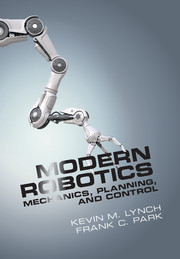Book contents
- Frontmatter
- Contents
- Foreword by Roger Brockett
- Foreword by Matthew Mason
- Preface
- 1 Preview
- 2 Configuration Space
- 3 Rigid-Body Motions
- 4 Forward Kinematics
- 5 Velocity Kinematics and Statics
- 6 Inverse Kinematics
- 7 Kinematics of Closed Chains
- 8 Dynamics of Open Chains
- 9 Trajectory Generation
- 10 Motion Planning
- 11 Robot Control
- 12 Grasping and Manipulation
- 13 Wheeled Mobile Robots
- A Summary of Useful Formulas
- B Other Representations of Rotations
- C Denavit–Hartenberg Parameters
- D Optimization and Lagrange Multipliers
- Bibliography
- Index
Foreword by Roger Brockett
Published online by Cambridge University Press: 04 June 2024
- Frontmatter
- Contents
- Foreword by Roger Brockett
- Foreword by Matthew Mason
- Preface
- 1 Preview
- 2 Configuration Space
- 3 Rigid-Body Motions
- 4 Forward Kinematics
- 5 Velocity Kinematics and Statics
- 6 Inverse Kinematics
- 7 Kinematics of Closed Chains
- 8 Dynamics of Open Chains
- 9 Trajectory Generation
- 10 Motion Planning
- 11 Robot Control
- 12 Grasping and Manipulation
- 13 Wheeled Mobile Robots
- A Summary of Useful Formulas
- B Other Representations of Rotations
- C Denavit–Hartenberg Parameters
- D Optimization and Lagrange Multipliers
- Bibliography
- Index
Summary
In the 1870s, Felix Klein was developing his far-reaching Erlangen Program, which cemented the relationship between geometry and group theoretic ideas. With Sophus Lie's nearly simultaneous development of a theory of continuous (Lie) groups, important new tools involving infinitesimal analysis based on Lie algebraic ideas became available for the study of a very wide range of geometric problems. Even today, the thinking behind these ideas continues to guide developments in important areas of mathematics. Kinematic mechanisms are, of course, more than just geometry; they need to accelerate, avoid collisions, etc., but first of all they are geometrical objects and the ideas of Klein and Lie apply. The groups of rigid motions in two or three dimensions, as they appear in robotics, are important examples in the work of Klein and Lie.
In the mathematics literature the representation of elements of a Lie group in terms of exponentials usually takes one of two different forms. These are known as exponential coordinates of the first kind and exponential coordinates of the second kind. For the first kind one has X = e(A1x1+A2x2··· ). For the second kind this is replaced by X = eA1x1eA2x2 · · · . Up until now, the first choice has found little utility in the study of kinematics whereas the second choice, a special case having already shown up in Euler parametrizations of the orthogonal group, turns out to be remarkably well-suited for the description of open kinematic chains consisting of the concatenation of single degree of freedom links. This is all nicely explained in Chapter 4 of this book. Together with the fact that PeAP−1 = ePAP−1 , the second form allows one to express a wide variety of kinematic problems very succinctly. From a historical perspective, the use of the product of exponentials to represent robotic movement, as the authors have done here, can be seen as illustrating the practical utility of the 150-year-old ideas of the geometers Klein and Lie.
In 1983 I was invited to speak at the triennial Mathematical Theory of Networks and Systems Conference in Beer Sheva, Israel, and after a little thought I decided to try to explain something about what my recent experiences had taught me.
- Type
- Chapter
- Information
- Modern RoboticsMechanics, Planning, and Control, pp. ix - xPublisher: Cambridge University PressPrint publication year: 2017

